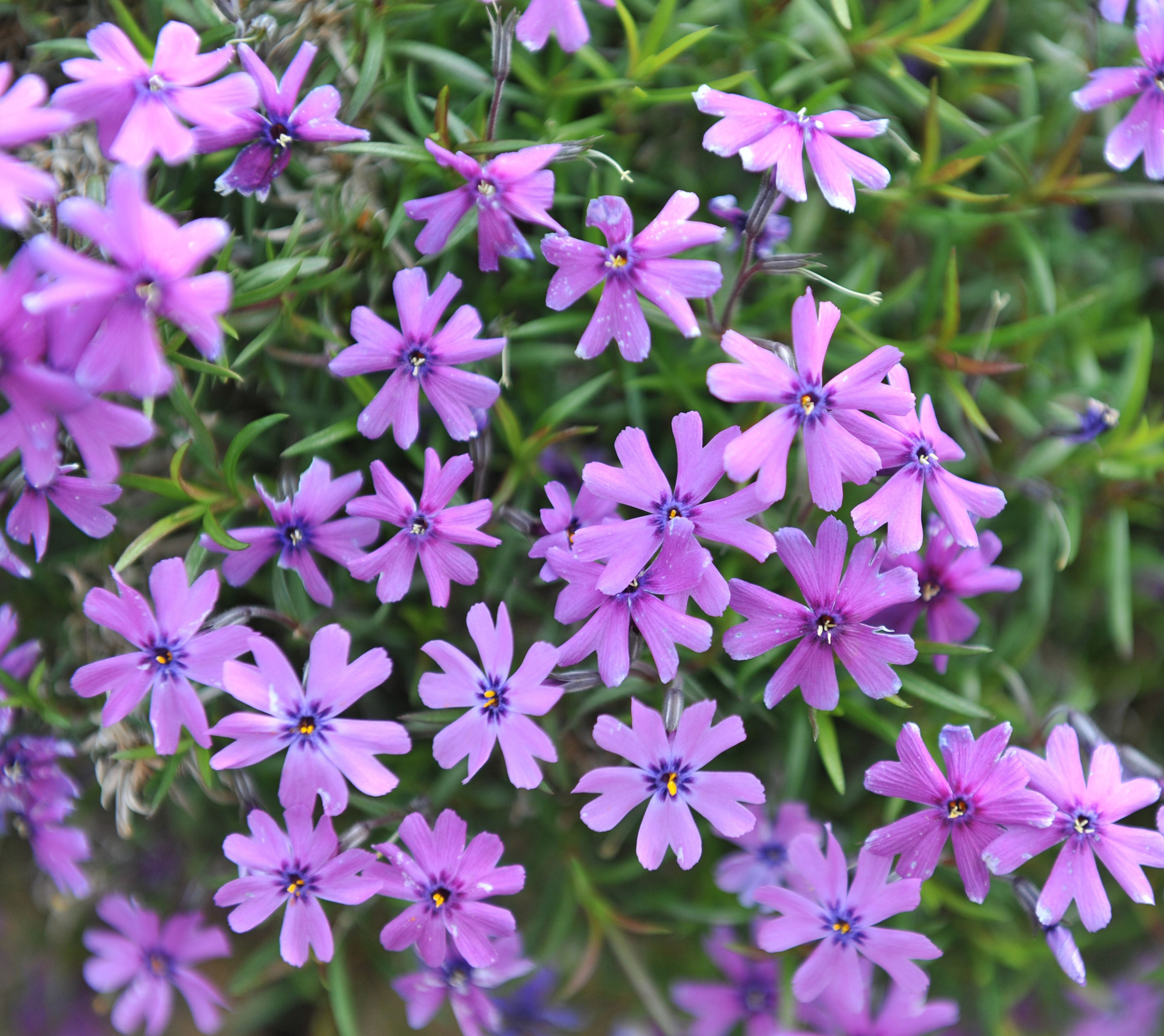A cheerful pop of spring color is an excellent reason to plant moss phlox, but this low-growing perennial continues to pull its weight during the rest of the year. It spreads quickly to form a dense, finely textured groundcover that controls erosion, smothers weeds, and remains green all year long. In early to mid-spring, the straight native becomes a stunning blanket of violet, pink, or white flowers. The fragrant, tubular flowers provide valuable early-season nectar for hummingbirds, swallowtail butterflies, and clearwing and hummingbird moths. The dramatic display lasts about two weeks before subsiding into a cushiony mat of needle-like foliage.
Moss phlox thrives in sun or light shade and in a variety of soils with good drainage. It has low to average water requirements and tolerates poor or rocky soils and drought once established. It’s native to the central and eastern portions of Canada and the US, especially in the Appalachians to North Carolina, and is often found in open woodlands or on sunny slopes or rocky ledges.
Gardeners have lots of options when landscaping with moss phlox. Some plant it en masse for a wave of color at fronts of borders or on sloping banks. Others plant it between pavers or along stone walls so that cushiony mats drape over the top. It’s also commonly used as an edger to define sidewalks, paths, and gardens. Moss phlox is resistant to deer, powdery mildew, black walnut, salt, and pollution.
When planting, space a foot apart and add plenty of organic matter to the soil. Add a layer of leaf mulch to retain moisture and support healthy microbial activity in the roots, As the plants age, dead growth accumulates underneath the upper layer of flowering stems. Older plants begin to thin out as new growth spreads away from the center of the plant. Annual pruning will regenerate the plants and help prevent disease. Simply lift the top growth and use pruners to snip dead stems back to ground level. If desired, cut back the stems by one-half when flowering has finished to help maintain shape and encourage dense growth.
P. subulata has a similar growth habit and bloom time as P. stolonifera, and both are sometimes called creeping phlox. However, moss phlox or moss pink is the most common name used for P. subulata, which has prickly and linear leaves, flowers with dark markings toward the center, notched petals, and a preference for sunny and dry conditions. It’s more tolerant of poor or sandy soils than creeping phlox, which has oblong leaves, flowers without dark markings, rounded petals, and a preference for moist woodland habitats. Moss phlox blooms more densely and has a tighter and more uniform appearance than creeping phlox. The genus name, Phlox, is from the Greek word phlox and means flame, which refers to the vibrant flower color of some of the varieties. Subulata means "awl-shaped," which refers to the shape of the leaves.
Native habitats include open woodlands, swamps, dry rocky or sandy areas, savannas, rocky ledges, slopes, and clearings. Use in containers, naturalized areas, on rock walls and slopes, in small spaces, and in sunny woodland gardens.
Plant Characteristics:
Grows 6" tall and 1-3' wide.
Prefers full sun or dappled sunlight.
Prefers moist or occasionally dry, acidic, well-drained soils, including rich, loamy, sandy, and shallowly rocky. Drought tolerant once established.
Loose, flattened clusters of 2-8 pink, violet, or white flowers bloom April-May. Each ¾” flower has 5 flat, rounded, notched petals arranged in a tubular corolla with 5 stamens and a pistil with a 3-parted style.
Oval-shaped, 4mm seed capsule has 3 valves with 3 or more seeds. The plant spreads by reseeding.
Opposite leaves are linear or awl shaped with sharp tips, 1/4 - 3/4” long, stalkless, and densely arranged. The smooth margins are fringed with white hairs.
Young stems are light green to purplish, hairy, and densely matted. Older stems become semi-woody and lose most of their foliage.
Wildlife Value:
Moss phlox is in the order Solanales, which is listed as a host plant for 7 species of Lepidoptera larvae, including olive and hitched arches, spotted straw sun moth, and purple-lined sallow (https://tinyurl.com/7953m66h). Flowers attract hummingbirds, butterflies, skippers, and bees.
Medicinal, Edible, and Other Uses:
None recorded.
top of page
$5.00Price
Excluding Sales Tax
Out of Stock
bottom of page

